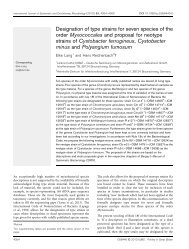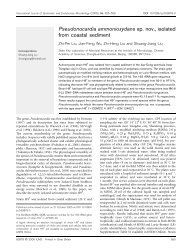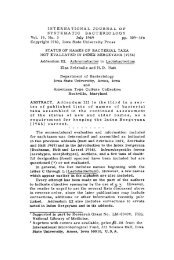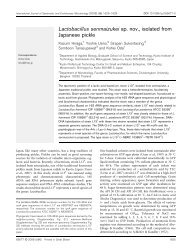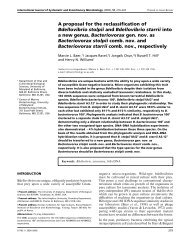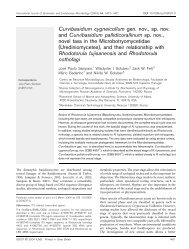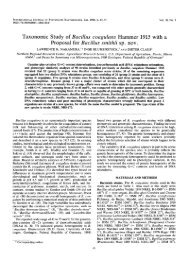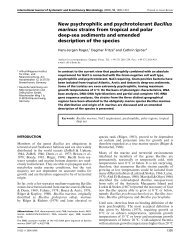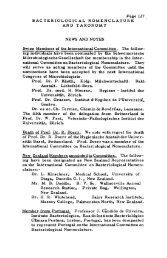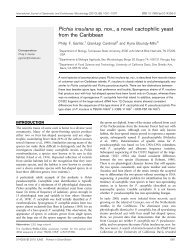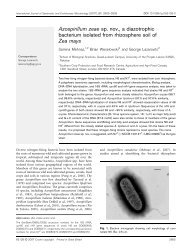Confirmation of Thiobacillus denitrificans as a species of the genus ...
Confirmation of Thiobacillus denitrificans as a species of the genus ...
Confirmation of Thiobacillus denitrificans as a species of the genus ...
Create successful ePaper yourself
Turn your PDF publications into a flip-book with our unique Google optimized e-Paper software.
International Journal <strong>of</strong> Systematic and Evolutionary Microbiology (2000), 50, 547–550<br />
Printed in Great Britain<br />
NOTE<br />
<strong>Confirmation</strong> <strong>of</strong> <strong>Thiobacillus</strong> <strong>denitrificans</strong> <strong>as</strong> a<br />
<strong>species</strong> <strong>of</strong> <strong>the</strong> <strong>genus</strong> <strong>Thiobacillus</strong>, in <strong>the</strong> β-<br />
subcl<strong>as</strong>s <strong>of</strong> <strong>the</strong> Proteobacteria, with strain<br />
NCIMB 9548 <strong>as</strong> <strong>the</strong> type strain<br />
Donovan P. Kelly 1 and Ann P. Wood 2<br />
Author for correspondence: Donovan P. Kelly. Tel: 44 24 7657 2907. Fax: 44 24 7652 3701.<br />
e-mail: mmzadna.bio.warwick.ac.uk<br />
1 Department <strong>of</strong> Biological<br />
Sciences, University <strong>of</strong><br />
Warwick, Coventry<br />
CV4 7AL, UK<br />
2 Microbiology Research<br />
Group, Division <strong>of</strong> Life<br />
Sciences, King’s College<br />
London, Franklin–Wilkins<br />
Building, 150 Stamford<br />
Street, London SE1 8WA,<br />
UK<br />
<strong>Thiobacillus</strong> <strong>denitrificans</strong> is physiologically similar to <strong>the</strong> type <strong>species</strong> <strong>of</strong> <strong>the</strong><br />
<strong>genus</strong> <strong>Thiobacillus</strong>, <strong>Thiobacillus</strong> thioparus, and both are located in <strong>the</strong> β-<br />
subcl<strong>as</strong>s <strong>of</strong> <strong>the</strong> Proteobacteria. T. <strong>denitrificans</strong> is distinguished from all o<strong>the</strong>r<br />
<strong>Thiobacillus</strong> <strong>species</strong> by its ability to grow <strong>as</strong> a facultatively anaerobic<br />
chemolithotroph, coupling <strong>the</strong> oxidation <strong>of</strong> inorganic sulfur compounds to <strong>the</strong><br />
reduction <strong>of</strong> nitrate, nitrite and o<strong>the</strong>r oxidized nitrogen compounds to<br />
dinitrogen. A definitive description <strong>of</strong> this <strong>species</strong> is provided and strain<br />
NCIMB 9548 T is designated <strong>as</strong> <strong>the</strong> type strain <strong>of</strong> <strong>the</strong> <strong>species</strong>, <strong>the</strong>reby correcting<br />
an earlier error in <strong>the</strong> literature.<br />
Keywords: <strong>Thiobacillus</strong> <strong>denitrificans</strong>, type strain NCIMB 9548T, <strong>Thiobacillus</strong><br />
taxonomy, 16S rDNA phylogeny, β-Proteobacteria<br />
At <strong>the</strong> time <strong>of</strong> <strong>the</strong> publication <strong>of</strong> <strong>the</strong> first edition <strong>of</strong><br />
Bergey’s Manual <strong>of</strong> Systematic Bacteriology (Kelly &<br />
Harrison, 1989a), <strong>Thiobacillus</strong> <strong>denitrificans</strong> w<strong>as</strong> not on<br />
<strong>the</strong> approved lists <strong>of</strong> bacterial names (Skerman et al.,<br />
1980). The original isolate (Beijerinck, 1904a, b) may<br />
not have been a pure culture (Vishniac & Santer,<br />
1957); that culture is no longer available in <strong>the</strong> Delft<br />
Culture Collection (L. A. Robertson, personal communication)<br />
or in any o<strong>the</strong>r culture collection. Later<br />
work proved that Beijerinck’s (1904a) designation w<strong>as</strong><br />
<strong>of</strong> a valid <strong>species</strong> exhibiting stable physiological<br />
characteristics (Lieske, 1912; Baalsrud & Baalsrud,<br />
1954; Hutchinson et al., 1967; Taylor et al., 1971;<br />
Baldensberger & Garcia, 1975; Justin & Kelly, 1978a;<br />
Katayama-Fujimura et al., 1982). Reports that its<br />
capacity to denitrify w<strong>as</strong> lost upon aerobic subculture<br />
and that it w<strong>as</strong> facultatively heterotrophic were<br />
erroneous. The name T. <strong>denitrificans</strong> w<strong>as</strong> <strong>the</strong>refore<br />
revived (Kelly & Harrison, 1989a) with a newly<br />
suggested neotype or reference strain, since <strong>the</strong> early<br />
isolates were no longer extant. The name appeared in<br />
International Journal <strong>of</strong> Systematic Bacteriology Validation<br />
List no. 31 (Kelly & Harrison, 1989b), but<br />
unfortunately <strong>the</strong> culture collection strain designated<br />
<strong>as</strong> representative <strong>of</strong> <strong>the</strong> type strain w<strong>as</strong> incorrectly<br />
.................................................................................................................................................<br />
The EMBL accession number for <strong>the</strong> 16S rRNA sequence <strong>of</strong> <strong>Thiobacillus</strong><br />
denitrifican is AJ243144.<br />
given <strong>as</strong> NCIB 8327. The correct designation is<br />
NCIMB 9548T; this correction w<strong>as</strong> published by <strong>the</strong><br />
National Collection <strong>of</strong> Industrial and Marine Bacteria<br />
(NCIMB, 1994) and w<strong>as</strong> corrected for <strong>the</strong> second<br />
edition <strong>of</strong> Bergey’s Manual <strong>of</strong> Systematic Bacteriology<br />
(Kelly & Wood, 2000a).<br />
This paper <strong>as</strong>sesses <strong>the</strong> designation <strong>of</strong> T. <strong>denitrificans</strong><br />
<strong>as</strong> a valid <strong>species</strong> <strong>of</strong> <strong>Thiobacillus</strong> and provides a<br />
definitive description <strong>of</strong> <strong>the</strong> <strong>species</strong>, with a clarification<br />
<strong>of</strong> <strong>the</strong> availability <strong>of</strong> <strong>the</strong> type strain in culture collections.<br />
Status <strong>of</strong> <strong>the</strong> <strong>genus</strong> <strong>Thiobacillus</strong> Beijerinck (1904a)<br />
The currently recognized <strong>species</strong> <strong>of</strong> <strong>Thiobacillus</strong> exhibit<br />
an extraordinarily wide range <strong>of</strong> physical growth<br />
conditions and great diversity in terms <strong>of</strong> <strong>the</strong> GC<br />
content <strong>of</strong> <strong>the</strong>ir DNA (50–68 mol%), <strong>the</strong> extent <strong>of</strong><br />
DNA hybridization, <strong>the</strong> range <strong>of</strong> ubiquinones and<br />
fatty acid content (Kelly & Harrison, 1989a; Kelly &<br />
Wood, 2000a). This diversity <strong>of</strong> properties among<br />
<strong>species</strong> w<strong>as</strong> indicative <strong>of</strong> an extremely heterogeneous<br />
group, judged in terms <strong>of</strong> genetic and physiological<br />
similarity, and 16S rDNA sequence analysis confirmed<br />
extreme diversity and consequent miscl<strong>as</strong>sification<br />
among <strong>the</strong> thiobacilli (McDonald et al., 1997). Consequently,<br />
various workers have proposed <strong>the</strong> <strong>as</strong>signment<br />
<strong>of</strong> some <strong>species</strong> to o<strong>the</strong>r genera or <strong>the</strong> creation <strong>of</strong><br />
01263 2000 IUMS 547
D. P. Kelly and A. P. Wood<br />
new genera for most <strong>of</strong> <strong>the</strong> former <strong>species</strong> <strong>of</strong> <strong>Thiobacillus</strong><br />
(Katayama et al., 1995; Moreira & Amils,<br />
1997; Hiraishi et al., 1998; Kelly & Wood, 2000b). In<br />
writing <strong>the</strong> chapter on <strong>Thiobacillus</strong> for <strong>the</strong> second<br />
edition <strong>of</strong> Bergey’s Manual <strong>of</strong> Systematic Bacteriology,<br />
we have confirmed <strong>the</strong> <strong>as</strong>signment <strong>of</strong> 14 <strong>species</strong> to new<br />
or different genera (Kelly & Wood, 2000a, b). Of <strong>the</strong><br />
remaining <strong>Thiobacillus</strong> <strong>species</strong>, only T. <strong>denitrificans</strong> is<br />
capable <strong>of</strong> facultative anaerobic growth with denitrification.<br />
The status <strong>of</strong> T. <strong>denitrificans</strong> after revision <strong>of</strong> <strong>the</strong><br />
<strong>genus</strong> <strong>Thiobacillus</strong> in 1999<br />
The type <strong>species</strong> <strong>of</strong> <strong>the</strong> <strong>Thiobacillus</strong> <strong>genus</strong>, <strong>Thiobacillus</strong><br />
thioparus (Beijerinck, 1904a), is a member <strong>of</strong> <strong>the</strong> β-<br />
subcl<strong>as</strong>s <strong>of</strong> <strong>the</strong> Proteobacteria, <strong>as</strong>isT. <strong>denitrificans</strong><br />
(Woese et al., 1984; Lane et al., 1992; H. G. Tru per,<br />
personal communication). T. <strong>denitrificans</strong>, like T.<br />
thioparus, exhibits obligate chemolithoautotrophy on<br />
a range <strong>of</strong> inorganic sulfur compounds and h<strong>as</strong><br />
numerous o<strong>the</strong>r physiological similarities in terms <strong>of</strong>,<br />
for example, pH- and temperature optima, <strong>the</strong> possession<br />
<strong>of</strong> ubiquinone Q-8, DNA b<strong>as</strong>e composition<br />
and fatty acid pr<strong>of</strong>iles (Agate & Vishniac, 1973;<br />
Katayama-Fujimura et al., 1982). T. <strong>denitrificans</strong><br />
is primarily characterized by its ability to grow<br />
<strong>as</strong> a facultative anaerobe, using nitrate and o<strong>the</strong>r<br />
oxidized nitrogen compounds in place <strong>of</strong> oxygen, a<br />
capacity that is absent in T. thioparus. A major<br />
structural difference between T. thioparus and T.<br />
<strong>denitrificans</strong> is shown by <strong>the</strong> presence (T. thioparus)or<br />
absence (T. <strong>denitrificans</strong>) <strong>of</strong> carboxysomes (polyhedral<br />
bodies largely composed <strong>of</strong> ribulose bisphosphate<br />
carboxyl<strong>as</strong>e) (Katayama-Fujimura et al., 1984;<br />
Shively et al., 1970). The wide range <strong>of</strong> comparative<br />
tests employed by Hutchinson et al. (1967, 1969)<br />
confirmed many similarities between T. <strong>denitrificans</strong><br />
and T. thioparus, but showed <strong>the</strong>m to be different from<br />
each o<strong>the</strong>r at <strong>the</strong> <strong>species</strong> level (Hutchinson et al., 1967).<br />
Recently, <strong>the</strong> 16S rRNA gene sequence <strong>of</strong> T. <strong>denitrificans</strong><br />
NCIMB 9548T w<strong>as</strong> shown to have 98% similarity<br />
to that <strong>of</strong> <strong>the</strong> type strain <strong>of</strong> T. thioparus (ATCC<br />
8185T; E. Stackebrandt, personal communication).<br />
The two <strong>species</strong> showed only 22–29% DNA–DNA<br />
hybridization (Katayama-Fujimura et al., 1983), confirming<br />
<strong>the</strong>m <strong>as</strong> distinct <strong>species</strong>.<br />
A striking feature <strong>of</strong> T. <strong>denitrificans</strong> is its greater<br />
growth yields on thiosulfate, both aerobically and<br />
anaerobically, relative to those <strong>of</strong> T. thioparus. Aerobic<br />
yields on thiosulfate or tetrathionate are approximately<br />
double those <strong>of</strong> T. thioparus and o<strong>the</strong>r physiologically<br />
similar chemolithotrophs (Justin & Kelly,<br />
1978a, b; Kelly, 1990, 2000a; Timmer-ten Hoor, 1976,<br />
1981). One characteristic <strong>of</strong> T. thioparus is its ability to<br />
grow on thiocyanate <strong>as</strong> a sole source <strong>of</strong> energy<br />
(Katayama et al., 1992; Kelly & Harrison, 1989a), a<br />
property apparently shared only with T. <strong>denitrificans</strong><br />
(among <strong>the</strong> thiobacilli). Beijerinck (1904a) reported<br />
025% ammonium thiocyanate giving rise to a pr<strong>of</strong>use<br />
deposition <strong>of</strong> elemental sulfur when provided in place<br />
<strong>of</strong> thiosulfate in <strong>the</strong> culture medium. Thiocyanate<br />
consumption w<strong>as</strong> reported by Hutchinson et al. (1965,<br />
1967, 1969) <strong>as</strong> a taxonomic characteristic <strong>of</strong> both T.<br />
<strong>denitrificans</strong> and T. thioparus. No quantitative study <strong>of</strong><br />
growth coupled to thiocyanate breakdown by T.<br />
<strong>denitrificans</strong> appears to have been done. De Kruyff et<br />
al. (1957) and Van der Walt & De Kruyff (1955)<br />
showed both aerobic and nitrate-dependent anaerobic<br />
use <strong>of</strong> thiocyanate by a strain <strong>of</strong> T. <strong>denitrificans</strong>:<br />
thiocyanate (26 mM) w<strong>as</strong> quantitatively converted to<br />
sulfate (87–94%) and elemental sulfur (6–13%). Thus,<br />
a definitive study <strong>of</strong> <strong>the</strong> biochemistry <strong>of</strong> thiocyanate<br />
metabolism in T. <strong>denitrificans</strong> is still required.<br />
Beijerinck’s (1904a) hope <strong>of</strong> returning to this question<br />
(‘… ein eigentu mlicher Biochemismus obwaltet, auf<br />
den ich spa ter zuru ckzukommen h<strong>of</strong>fe’) seems to have<br />
been unfulfilled. Lieske (1912) reported growth (‘ein<br />
sehr gutes Wachstum’) <strong>of</strong> T. <strong>denitrificans</strong> on sodium<br />
dithionate (Na <br />
S <br />
O <br />
) but this w<strong>as</strong> not confirmed by<br />
Hutchinson et al. (1967, 1969), although <strong>the</strong>y did<br />
report weak use <strong>of</strong> dithionate by T. thioparus<br />
(Hutchinson et al., 1969). There seems to have been no<br />
o<strong>the</strong>r report <strong>of</strong> dithionate <strong>as</strong> a sole substrate by T.<br />
<strong>denitrificans</strong>; quantitative studies <strong>of</strong> both thiocyanate<br />
and dithionate <strong>as</strong> possible substrates remain to be<br />
performed with this organism.<br />
Description <strong>of</strong> <strong>Thiobacillus</strong> <strong>denitrificans</strong> (ex Beijerinck<br />
1904a) nom. rev. Kelly and Harrison (1989a)<br />
<strong>Thiobacillus</strong> <strong>denitrificans</strong> (de.ni.trifi.cans. M.L. v.<br />
denitrifico denitrify; M.L. part. adj. <strong>denitrificans</strong><br />
denitrifying).<br />
Short rods 0510–30 µm in size. May be motile by<br />
means <strong>of</strong> a polar flagellum. Clear or weakly opalescent<br />
colonies are grown anaerobically on thiosulfate<br />
nitrate agar, which upon ageing may become white<br />
with sulfur. Growth in anaerobic stab- or roll culture<br />
results in agar splitting due to production <strong>of</strong> nitrogen<br />
g<strong>as</strong>. Facultatively anaerobic. Grows <strong>as</strong> an aerobic<br />
chemolithoautotroph on thiosulfate, tetrathionate and<br />
thiocyanate. Grows <strong>as</strong> an anaerobic chemolithoautotroph<br />
on thiosulfate, tetrathionate, thiocyanate,<br />
sulfide or elemental sulfur by using nitrate, nitrite or<br />
nitrous oxide <strong>as</strong> terminal respiratory oxidants; transient<br />
formation and consumption <strong>of</strong> nitric oxide h<strong>as</strong><br />
been observed. Oxidizes sulfur, sulfide, thiosulfate,<br />
tetrathionate, sulfite and thiocyanate. Batch cultures<br />
can be grown in completely filled bottles, producing<br />
vigorous nitrogen evolution. Chemostat culture can be<br />
switched e<strong>as</strong>ily and repeatedly between aerobic and<br />
anaerobic growth modes, with adaptation involving<br />
derepression <strong>of</strong> nitrate and nitrite reduct<strong>as</strong>e syn<strong>the</strong>sis.<br />
Ammonium salts and, in some strains at le<strong>as</strong>t, nitrate<br />
are used <strong>as</strong> nitrogen sources. Obligately chemolithotrophic<br />
and autotrophic. Optimum temperature<br />
28–32 C. Optimum pH 68–74. Found in soil, mud,<br />
freshwater- and marine sediments and also in domestic<br />
sewage and industrial w<strong>as</strong>te-treatment lagoons and<br />
548 International Journal <strong>of</strong> Systematic and Evolutionary Microbiology 50
Type strain <strong>of</strong> <strong>Thiobacillus</strong> <strong>denitrificans</strong><br />
digestion tanks, especially under anoxic conditions.<br />
Probably very widely distributed. The GC content<br />
<strong>of</strong> <strong>the</strong> DNA is 63 mol% (Bd, T m<br />
). The type strain is<br />
NCIMB 9548T. This is <strong>the</strong> strain (AB7) deposited by<br />
Hutchinson et al. (1967), which is also available <strong>as</strong><br />
ATCC 23644T and JCM 3870T. A member <strong>of</strong> <strong>the</strong> β-<br />
Proteobacteria.<br />
Acknowledgements<br />
We thank Erko Stackebrandt and Hans Tru per for advice<br />
and for giving us unpublished information.<br />
References<br />
Agate, A. D. & Vishniac, W. (1973). Characterization <strong>of</strong> <strong>Thiobacillus</strong><br />
<strong>species</strong> by g<strong>as</strong>–liquid chromatography <strong>of</strong> cellular fatty<br />
acids. Arch Mikrobiol 89, 257–267.<br />
Baalsrud, K. & Baalsrud, K. S. (1954). Studies on <strong>Thiobacillus</strong><br />
<strong>denitrificans</strong>. Arch Mikrobiol 20, 34–62.<br />
Baldensperger, J. & Garcia, J.-L. (1975). Reduction <strong>of</strong> oxidized<br />
inorganic nitrogen compounds by a new strain <strong>of</strong> <strong>Thiobacillus</strong><br />
<strong>denitrificans</strong>. Arch Microbiol 103, 31–36.<br />
Beijerinck, M. W. (1904a). Ueber die Bakterien, welche sich im<br />
Dunkeln mit Kohlensa ure als Kohlenst<strong>of</strong>fquelle erna hren<br />
ko nnen. Centralbl Bakteriol Par<strong>as</strong>itenkd Infektionskr Hyg Abt<br />
II 11, 593–599.<br />
Beijerinck, M. W. (1904b). Phe nome nes de re duction produits<br />
par les microbes (Confe rence avec de monstrations faite – Delft,<br />
le 16 avril 1903). Archs Nee rl Sci Ser 2 9, 131–157.<br />
De Kruyff, C. D., Van der Walt, J. P. & Schwartz, H. M. (1957). The<br />
utilisation <strong>of</strong> thiocyanate and nitrate by thiobacilli. Antonie<br />
Leeuwenhoek 23, 305–316.<br />
Hiraishi, A., Nag<strong>as</strong>hima, K. V. P., Katayama, Y., Shimada, K.,<br />
Takaichi, S., Wakao, N. & Katayama, Y. (1998). Phylogeny and<br />
photosyn<strong>the</strong>tic features <strong>of</strong> <strong>Thiobacillus</strong> acidophilus and related<br />
acidophilic bacteria: its transfer to <strong>the</strong> <strong>genus</strong> Acidiphilium <strong>as</strong><br />
Acidiphilium acidophilum comb. nov. Int J Syst Bacteriol 48,<br />
1389–1398.<br />
Hutchinson, M., Johnstone, K. I. & White, D. (1965). The<br />
taxonomy <strong>of</strong> certain thiobacilli. J Gen Microbiol 41, 357–366.<br />
Hutchinson, M., Johnstone, K. I. & White, D. (1967). Taxonomy<br />
<strong>of</strong> anaerobic thiobacilli. J Gen Microbiol 47, 17–23.<br />
Hutchinson, M., Johnstone, K. I. & White, D. (1969). Taxonomy<br />
<strong>of</strong> <strong>the</strong> <strong>genus</strong> <strong>Thiobacillus</strong>: <strong>the</strong> outcome <strong>of</strong> numerical taxonomy<br />
applied to <strong>the</strong> group <strong>as</strong> a whole. J Gen Microbiol 57, 397–410.<br />
Justin, P. & Kelly, D. P. (1978a). Oxidation kinetics <strong>of</strong> <strong>Thiobacillus</strong><br />
<strong>denitrificans</strong> in anaerobic and aerobic chemostat culture. J Gen<br />
Microbiol 107, 123–130.<br />
Justin, P. & Kelly, D. P. (1978b). Metabolic changes in <strong>Thiobacillus</strong><br />
<strong>denitrificans</strong> accompanying transition from aerobic to<br />
anaerobic growth in continuous chemostat culture. J Gen<br />
Microbiol 107, 131–137.<br />
Katayama, Y., Ranahara, Y., Inoue, Y., Amano, F., Kanagawa, T.<br />
& Kuraishi, H. (1992). A thiocyanate hydrol<strong>as</strong>e <strong>of</strong> <strong>Thiobacillus</strong><br />
thioparus. J Biol Chem 267, 9170–9175.<br />
Katayama, Y., Hiraishi, A. & Kuraishi, H. (1995). Paracoccus<br />
thiocyanatus sp. nov., a new <strong>species</strong> <strong>of</strong> thiocyanate-utilizing<br />
facultative chemolithotroph, and transfer <strong>of</strong> <strong>Thiobacillus</strong><br />
versutus to <strong>the</strong> <strong>genus</strong> Paracoccus <strong>as</strong> Paracoccus versutus<br />
comb. nov. with emendation <strong>of</strong> <strong>the</strong> <strong>genus</strong>. Microbiology 141,<br />
1469–1477.<br />
Katayama-Fujimura, Y., Tsuzaki, N. & Kuraishi, H. (1982).<br />
Ubiquinone, fatty acid and DNA b<strong>as</strong>e composition determination<br />
<strong>as</strong> a guide to <strong>the</strong> taxonomy <strong>of</strong> <strong>the</strong> <strong>genus</strong> <strong>Thiobacillus</strong>.<br />
J Gen Microbiol 128, 1599–1611.<br />
Katayama-Fujimura, Y., Enokizono, Y., Kaneko, T. & Kuraishi, H.<br />
(1983). Deoxyribonucleic acid homologies among <strong>species</strong> <strong>of</strong> <strong>the</strong><br />
<strong>genus</strong> <strong>Thiobacillus</strong>. J Gen Appl Microbiol 29, 287–295.<br />
Katayama-Fujimura, Y., Tsuzaki, N., Hirata, A. & Kuraishi, H.<br />
(1984). Polyhedral inclusion bodies (carboxysomes) in <strong>Thiobacillus</strong><br />
<strong>species</strong> with reference to <strong>the</strong> taxonomy <strong>of</strong> <strong>the</strong> <strong>genus</strong><br />
<strong>Thiobacillus</strong>. J Gen Appl Microbiol 30, 211–222.<br />
Kelly, D. P. (1990). Energetics <strong>of</strong> chemolithotrophs. In The<br />
Bacteria. A Treatise on Structure and Function, vol. 12, Bacterial<br />
Energetics, pp. 479–503. Edited by T. A. Krulwich. San Diego:<br />
Academic Press.<br />
Kelly, D. P. (1999). Thermodynamic <strong>as</strong>pects <strong>of</strong> energy conservation<br />
by chemolithotrophic sulfur bacteria in relation to <strong>the</strong><br />
sulfur oxidation pathways. Arch Microbiol 171, 219–229.<br />
Kelly, D. P. & Harrison, A. H. (1989a). Genus <strong>Thiobacillus</strong>. In<br />
Bergey’s Manual <strong>of</strong> Systematic Bacteriology, vol. 3, pp.<br />
1842–1858. Edited by J. T. Staley, M. P. Bryant, N. Pfennig &<br />
J. G. Holt. Baltimore: Williams & Wilkins.<br />
Kelly, D. P. & Harrison, A. H. (1989b). <strong>Thiobacillus</strong> <strong>denitrificans</strong><br />
nom. rev. In Validation <strong>of</strong> <strong>the</strong> Publication <strong>of</strong> New Names and<br />
New Combinations Previously Effectively Published Outside <strong>the</strong><br />
IJSB, List no. 31. Int J Syst Bacteriol 39, 495–497.<br />
Kelly, D. P. & Wood, A. P. (2000a). Genus <strong>Thiobacillus</strong> Beijerinck.<br />
In Bergey’s Manual <strong>of</strong> Systematic Bacteriology, 2nd edn, vol. 2.<br />
Edited by N. R. Krieg, J. T. Staley & D. J. Brenner. Michigan:<br />
Bergey’s Manual Trust (in press).<br />
Kelly, D. P. & Wood, A. P. (2000b). Recl<strong>as</strong>sification <strong>of</strong> some<br />
<strong>species</strong> <strong>of</strong> <strong>Thiobacillus</strong> to <strong>the</strong> newly designated genera Acidithiobacillus<br />
gen. nov., Halothiobacillus gen. nov. and Thermithiobacillus<br />
gen. nov. Int J Syst Evol Microbiol 50, 511–516.<br />
Lane, D. J., Harrison, A. P., Stahl, D., Pace, B., Giovannoni, S. J.,<br />
Olsen, G. J. & Pace, N. R. (1992). Evolutionary relationships<br />
among sulfur- and iron-oxidizing bacteria. J Bacteriol 174,<br />
269–278.<br />
Lieske, R. (1912). Untersuchungen u ber die Physiologie denitrifizierender<br />
Schwefelbakterien. Ber deutschen botan Gesell 30,<br />
12–22.<br />
McDonald, I. R., Kelly, D. P., Murrell, J. C. & Wood, A. P. (1997).<br />
Taxonomic relationships <strong>of</strong> <strong>Thiobacillus</strong> halophilus, <strong>Thiobacillus</strong><br />
aquaesulis, and o<strong>the</strong>r <strong>species</strong> <strong>of</strong> <strong>Thiobacillus</strong>, <strong>as</strong> determined<br />
using 16S rRNA sequencing. Arch Microbiol 166, 394–398.<br />
Moreira, D. & Amils, R. (1997). Phylogeny <strong>of</strong> <strong>Thiobacillus</strong> cuprinus<br />
and o<strong>the</strong>r mixotrophic thiobacilli: proposal for Thiomon<strong>as</strong> gen.<br />
nov. Int J Syst Bacteriol 47, 522–528.<br />
NCIMB (1994). Catalogue <strong>of</strong> Strains. Aberdeen: National Collection<br />
<strong>of</strong> Industrial and Marine Bacteria.<br />
Shively, J. M., Decker, G. L. & Greenawalt, J. W. (1970). Comparative<br />
ultr<strong>as</strong>tructure <strong>of</strong> <strong>the</strong> thiobacilli. J Bacteriol 101,<br />
618–627.<br />
Skerman, V. B. D., McGowan, V. & Sneath, P. H. A. (1980).<br />
Approved lists <strong>of</strong> bacterial names. Int J Syst Bacteriol 30,<br />
225–238.<br />
Taylor, B. F., Hoare, D. S. & Hoare, S. L. (1971). <strong>Thiobacillus</strong><br />
International Journal <strong>of</strong> Systematic and Evolutionary Microbiology 50 549
D. P. Kelly and A. P. Wood<br />
<strong>denitrificans</strong> <strong>as</strong> an obligate chemolithotroph. Isolation and<br />
growth studies. Arch Mikrobiol 78, 193–204.<br />
Timmer-ten Hoor, A. (1976). Energetic <strong>as</strong>pects <strong>of</strong> <strong>the</strong> metabolism<br />
<strong>of</strong> reduced sulphur compounds in <strong>Thiobacillus</strong> <strong>denitrificans</strong>.<br />
Antonie Leeuwenhoek 42, 483–492.<br />
Timmer-ten Hoor, A. (1981). Cell yield and bioenergetics <strong>of</strong><br />
Thiomicrospira <strong>denitrificans</strong> compared with <strong>Thiobacillus</strong><br />
<strong>denitrificans</strong>. Antonie Leeuwenhoek 47, 231–243.<br />
Van der Walt, J. P. & De Kruyff, C. D. (1955). Anaerobic<br />
metabolism <strong>of</strong> thiocyanate by thiobacilli. Nature 176, 310–311.<br />
Vishniac, W. & Santer, M. (1957). The thiobacilli. Bacteriol Rev<br />
21, 195–213.<br />
Woese, C. R., Weisburg, W. G., P<strong>as</strong>ter, B. J., Hahn, C. M., Tanner,<br />
R. S., Krieg, N. R., Koops, H.-P., Harms, H. & Stackebrandt, E.<br />
(1984). The phylogeny <strong>of</strong> purple bacteria: <strong>the</strong> beta subdivision.<br />
Syst Appl Microbiol 5, 327–336.<br />
550 International Journal <strong>of</strong> Systematic and Evolutionary Microbiology 50



